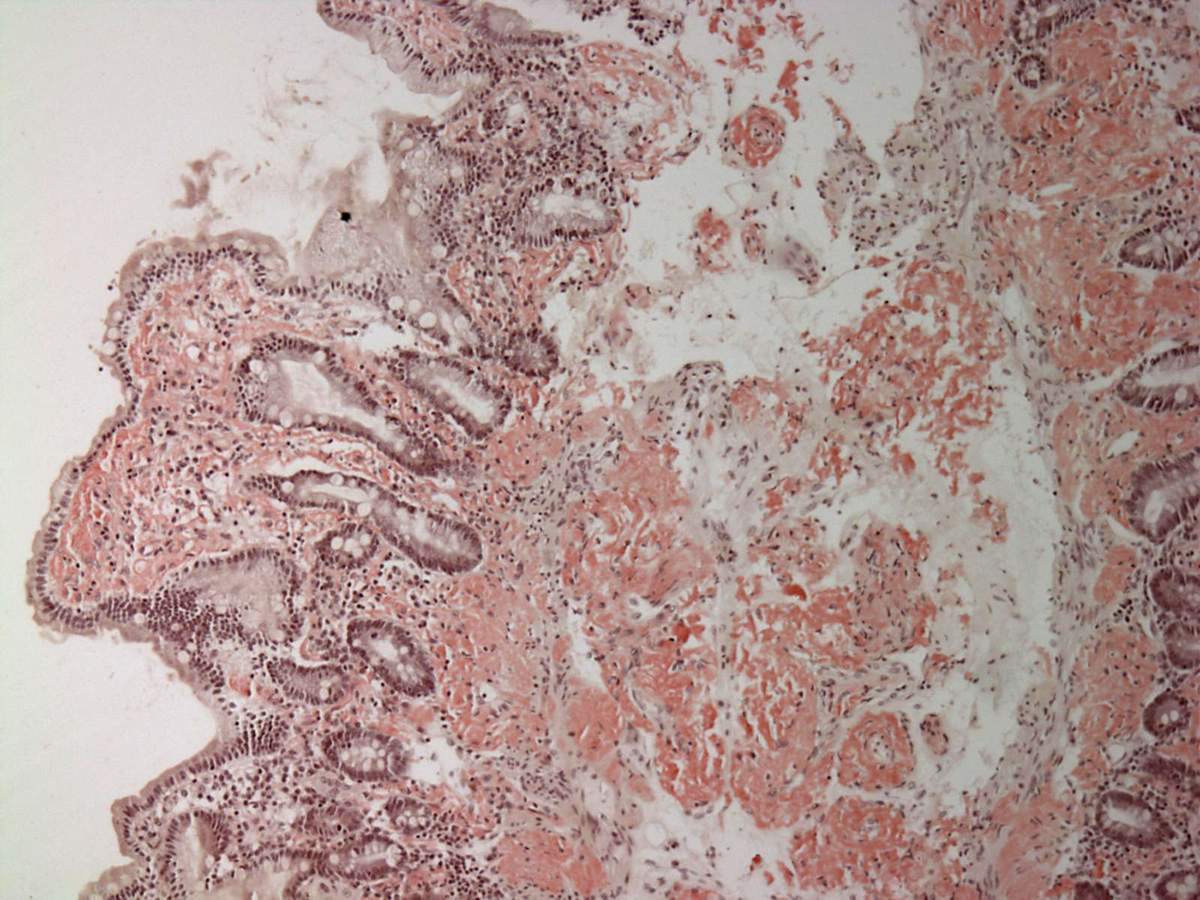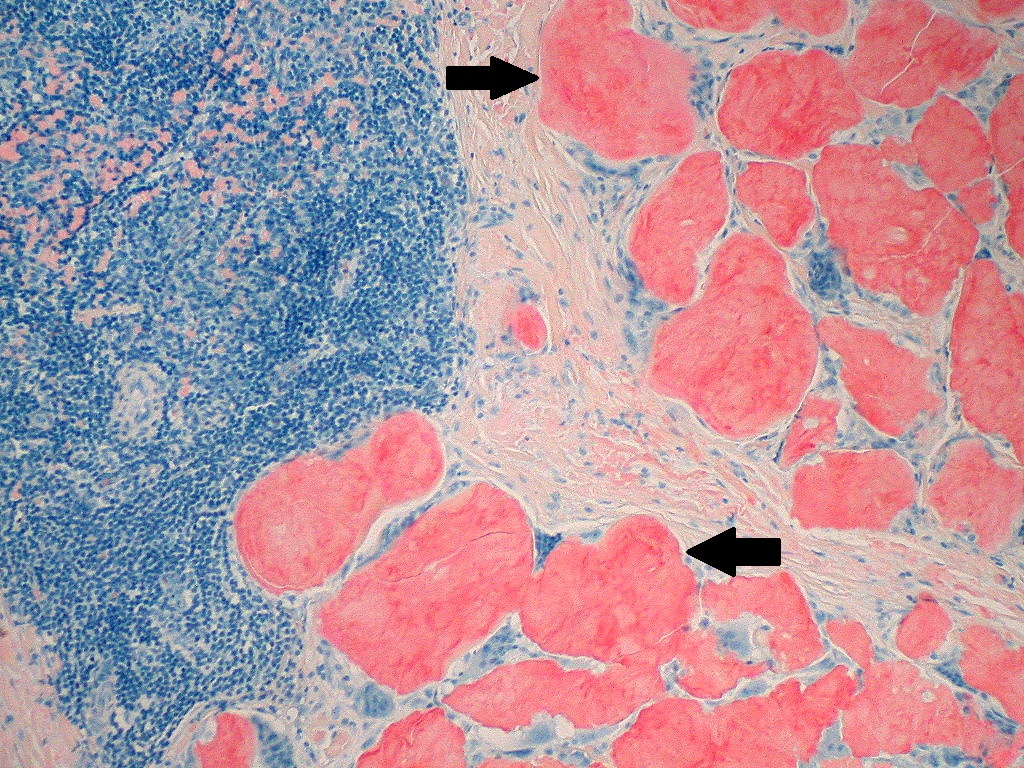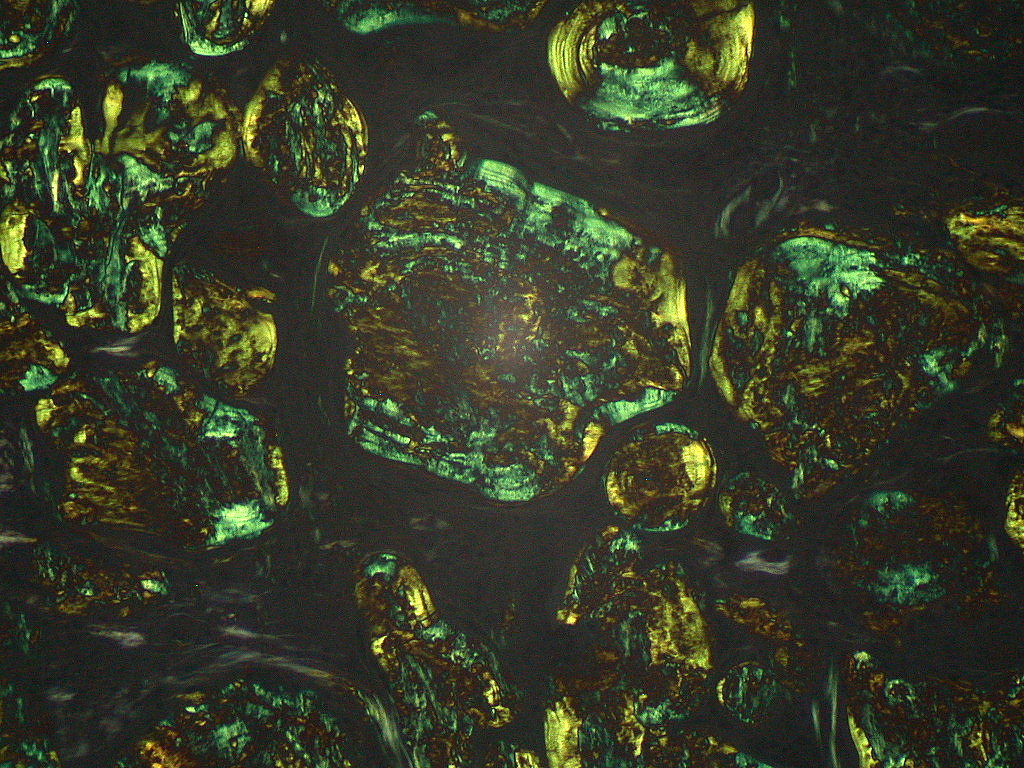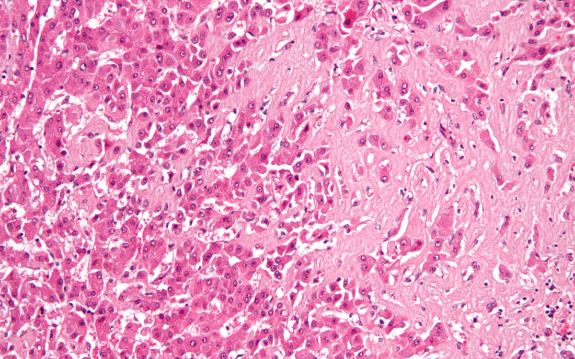Primary amyloidosis pathophysiology: Difference between revisions
| (10 intermediate revisions by the same user not shown) | |||
| Line 4: | Line 4: | ||
== Overview == | == Overview == | ||
[[Amyloid]] is an abnormal insoluble [[extracellular]] [[protein]] that deposits in the different tissues and causes organic dysfunction and a wide variety of clinical syndromes. In primary amyloidosis, [[amyloid]] gradually accumulate and [[amyloid]] deposition is widespread in the viscera (mainly kidneys, heart and liver), [[blood vessel]] walls, and in | [[Amyloid]] is an abnormal insoluble [[extracellular]] [[protein]] that deposits in the different tissues and causes organic dysfunction and a wide variety of clinical syndromes. In primary amyloidosis, [[amyloid]] gradually accumulate and [[amyloid]] deposition is widespread in the [[viscera]] (mainly [[kidneys]], heart and liver), [[blood vessel]] walls, [[nerves]] and in different [[Connective tissue|connective tissues]]. Primary (AL) amyloidosis) is the most common type of amyloidosis. It results from aggregation and deposition of monoclonal [[Immunoglobulin|immunoglobulin (Ig)]] [[Light chain|light chains]] that usually produced by [[plasma cell]] clones. | ||
== Pathophysiology == | == Pathophysiology == | ||
[[Amyloid]] is an abnormal insoluble [[extracellular]] [[protein]] that deposits in the different tissues and causes organic dysfunction and a wide variety of clinical syndromes. In primary amyloidosis, [[amyloid]] gradually accumulate and [[amyloid]] deposition is widespread in the viscera (mainly kidneys, heart and liver), [[blood vessel]] walls, and in | [[Amyloid]] is an abnormal insoluble [[extracellular]] [[protein]] that deposits in the different tissues and causes organic dysfunction and a wide variety of clinical syndromes. In primary amyloidosis, [[amyloid]] gradually accumulate and [[amyloid]] deposition is widespread in the [[viscera]] (mainly [[kidneys]], [[heart]] and [[liver]]), [[blood vessel]] walls, and in different [[Connective tissue|connective tissues]]. | ||
=== Pathogenesis === | === Pathogenesis === | ||
'''Amyloids''' | '''Amyloids''' | ||
* Amyloids consist of aggregated proteins that accumulate extracellularly as insoluble fibrils of misfolded proteins. Pathogenic amyloids are the consequence of previously normal proteins that lose their physiological properties and assume a beta-pleated quaternary configuration with a characteristic appearance on electron microscopy. The axis of the fiber (5-15nm in width) in these deposits is perpendicular to antiparallel chains of beta peptides. | *[[Amyloid|Amyloids]] consist of aggregated [[proteins]] that accumulate [[Extracellular|extracellularly]] as insoluble [[Fibril|fibrils]] of misfolded [[proteins]]. Pathogenic [[Amyloid|amyloids]] are the consequence of previously normal [[proteins]] that lose their physiological properties and assume a [[Beta-pleated sheet|beta-pleated]] [[Quaternary amine|quaternary]] configuration with a characteristic appearance on [[electron microscopy]]. The axis of the fiber (5-15nm in width) in these deposits is perpendicular to antiparallel chains of beta [[peptides]]. | ||
* These misfolded proteins are seen in various diseases such as Alzheimer's disease (beta-amyloid), diabetes mellitus type 2 (amylin), Parkinson's disease (alpha-synuclein), fatal familial insomnia (PrPsc), Huntington's disease (Huntingtin), medullary carcinoma of the thyroid (calcitonin), atherosclerosis (apolipiprotein A-I), rheumatoid arthritis (serm amyloid A), Lattice corneal dystrophy (keratoepithelin) and trasnmissible spongiform encephalopathy (PrP). | * These misfolded proteins are seen in various diseases such as [[Alzheimer's disease]] (beta-amyloid), [[diabetes mellitus type 2]] ([[amylin]]), [[Parkinson's disease]] ([[alpha-synuclein]]), [[fatal familial insomnia]] (PrPsc), [[Huntington's disease]] ([[Huntingtin]]), [[medullary carcinoma of the thyroid]] ([[calcitonin]]), [[atherosclerosis]] ([[ApoAI|apolipiprotein A-I]]), [[rheumatoid arthritis]] (serm amyloid A), Lattice corneal dystrophy (keratoepithelin) and trasnmissible spongiform encephalopathy (PrP). | ||
*Amyloid fibrils are composed of smaller amyloid oligomers, which are toxic. Amyloid fibrils, once formed, catalyze the formation of these toxic oligomers. | *[[Amyloid]] fibrils are composed of smaller amyloid oligomers, which are toxic. Amyloid fibrils, once formed, [[catalyze]] the formation of these toxic oligomers. | ||
'''Light chain amyloid or AL amyloid''' | '''Light chain amyloid or AL amyloid''' | ||
* Primary amyloidosis is characterized by multi-organ deposition of immunoglobulin light chains of lambda variety. These light chains are normal components of antibodies produced by plasma cells (fully differentiated B cells). The [[Plasma cell|plasma cells]] are involved in [[antibody]] production under physiological conditions via reorganization of [[immunoglobulin]] [[Heavy chains|heavy]] and [[Light chain|light chains]]. | * Primary amyloidosis is characterized by multi-organ deposition of [[immunoglobulin light chains]] of lambda variety. These [[Light chain|light chains]] are normal components of [[antibodies]] produced by [[plasma cells]] (fully [[Differentiate|differentiated]] [[B cells]]). The [[Plasma cell|plasma cells]] are involved in [[antibody]] production under [[physiological]] conditions via reorganization of [[immunoglobulin]] [[Heavy chains|heavy]] and [[Light chain|light chains]]. | ||
* Since primary amyloidosis occurs in patients suffering from plasma cell dyscrasias, the inciting event for primary or AL amyloidosis is formation of an unstable misfolded secondary or tertiary structure of a monoclonal plasma cell-derived immunoglobulin light chain. | * Since primary amyloidosis occurs in patients suffering from [[plasma cell dyscrasias]], the inciting event for primary or AL amyloidosis is formation of an unstable misfolded [[Secondary amine|secondary]] or [[Tertiary amine|tertiary]] structure of a [[monoclonal]] [[plasma cell]]-derived [[Immunoglobulin light chains|immunoglobulin light chain]]. | ||
'''Role of plasma cells in primary (AL) amyloidosis''' | '''Role of plasma cells in primary (AL) amyloidosis''' | ||
* In primary amyloidosis, the marrow plasma cell burden is < 10% therefore, primary amyloidosis is not considered a neoplasm. Due to monoclonal proliferation of these mature B cells, only one type of a unique protein sequence is synthesized. | * In primary amyloidosis, the [[Bone marrow|marrow]] [[plasma cell]] burden is < 10% therefore, primary amyloidosis is not considered a [[neoplasm]]. Due to [[monoclonal]] proliferation of these mature [[B cells]], only one type of a unique [[protein]] sequence is synthesized. | ||
*The mutational pattern of primary amyloidosis is intermediate between those of monoclonal gammopathy of undetermined significance and multiple myeloma. | *The [[Mutation|mutational]] pattern of primary amyloidosis is intermediate between those of [[monoclonal gammopathy of undetermined significance]] and [[multiple myeloma]]. | ||
* Studies have shown that in immunoglobulins produced by monoclonal plasma cell proliferation, there is alteration in the dimer interface formed between the variable domain of the light chains and the variable domain of the heavy chains. Mutations that disrupt immunoglobulin folds (structural domain) of beta strands lead to abnormal folding (N- and C-terminals oriented in opposite directions) and decreased thermodynamic stability. | * Studies have shown that in [[immunoglobulins]] produced by [[monoclonal]] [[plasma cell]] proliferation, there is alteration in the dimer interface formed between the variable domain of the [[Light chain|light chains]] and the variable domain of the [[heavy chains]]. [[Mutations]] that disrupt [[immunoglobulin]] folds (structural domain) of beta strands lead to abnormal folding ([[N terminus|N]]- and [[C-terminal end|C-terminals]] oriented in opposite directions) and decreased thermodynamic stability. | ||
* Therefore, destabilizing somatic mutations are present in both the complementarity-determining regions and structural regions of light chains and are thought to increase the propensity to develop insoluble aggregates. | * Therefore, destabilizing [[Somatic mutation|somatic mutations]] are present in both the complementarity-determining regions and structural regions of [[Light chain|light chains]] and are thought to increase the propensity to develop insoluble aggregates. | ||
* Because of somatic hypermutations, the amino acid sequence of the pathogenic AL protein differs in each patient | * Because of [[Somatic hypermutation|somatic hypermutations]], the [[amino acid]] sequence of the pathogenic AL protein differs in each patient. | ||
'''Interaction of amyloid fibrils with microenvironment''' | '''Interaction of amyloid fibrils with microenvironment''' | ||
* Accumulation of insoluble amyloid fibrils in tissues leads to activation proteosomes that lead to their endoproteolysis and release of amyloidogenic light chain fragments. | * Accumulation of insoluble amyloid fibrils in tissues leads to activation proteosomes that lead to their [[Proteolysis|endoproteolysis]] and release of amyloidogenic [[light chain]] fragments. | ||
* Interaction of these deposits with extracellular chaperones, matrix components including glycosaminoglycans (GAGs) and collagen, shear forces, endoproteases, and metals modulate aggregation and oligomer formation. | * Interaction of these deposits with [[Chaperone (protein)|extracellular chaperones]], [[Matrix (biology)|matrix]] components including [[glycosaminoglycans]] (GAGs) and [[collagen]], shear forces, [[Proteases|endoproteases]], and metals modulate aggregation and oligomer formation. | ||
'''Tissue damage''' | '''Tissue damage''' | ||
* The deposition of amyloid aggregates leads to architectural disruptions in tissues. | * The deposition of [[amyloid]] aggregates leads to architectural disruptions in [[tissues]]. | ||
* Amyloid fibrils may also produce organ dysfunction via | *[[Amyloid]] fibrils may also produce organ dysfunction via interaction with ligands and disruption of [[cell membranes]]. | ||
* Both cytotoxicity and apoptosis have been implicated as mechanisms leading to tissue injury in primary amyloidosis.<ref name="RiekEisenberg2016">{{cite journal|last1=Riek|first1=Roland|last2=Eisenberg|first2=David S.|title=The activities of amyloids from a structural perspective|journal=Nature|volume=539|issue=7628|year=2016|pages=227–235|issn=0028-0836|doi=10.1038/nature20416}}</ref> | * Both [[cytotoxicity]] and [[apoptosis]] have been implicated as mechanisms leading to tissue injury in primary amyloidosis.<ref name="RiekEisenberg2016">{{cite journal|last1=Riek|first1=Roland|last2=Eisenberg|first2=David S.|title=The activities of amyloids from a structural perspective|journal=Nature|volume=539|issue=7628|year=2016|pages=227–235|issn=0028-0836|doi=10.1038/nature20416}}</ref> | ||
* Specificity for a particular organ in primary amyloidosis depends upon the light chain variable region gene and gene family of the clone. Germ line gene LV6-57 is more common in AL systemic amyloidosis and is associated with renal involvement, while LV1-44 preferentially leads to fibril deposition in the heart and KV1-33 is associated with hepatic involvement.<ref name="pmid22067386">{{cite journal |vauthors=Perfetti V, Palladini G, Casarini S, Navazza V, Rognoni P, Obici L, Invernizzi R, Perlini S, Klersy C, Merlini G |title=The repertoire of λ light chains causing predominant amyloid heart involvement and identification of a preferentially involved germline gene, IGLV1-44 |journal=Blood |volume=119 |issue=1 |pages=144–50 |date=January 2012 |pmid=22067386 |doi=10.1182/blood-2011-05-355784 |url=}}</ref> | * Specificity for a particular organ in primary amyloidosis depends upon the [[light chain]] [[Hypervariable region|variable region gene]] and gene family of the clone. [[Germ line]] [[gene]] LV6-57 is more common in AL systemic amyloidosis and is associated with [[renal]] involvement, while LV1-44 preferentially leads to fibril deposition in the [[heart]] and KV1-33 is associated with [[hepatic]] involvement.<ref name="pmid22067386">{{cite journal |vauthors=Perfetti V, Palladini G, Casarini S, Navazza V, Rognoni P, Obici L, Invernizzi R, Perlini S, Klersy C, Merlini G |title=The repertoire of λ light chains causing predominant amyloid heart involvement and identification of a preferentially involved germline gene, IGLV1-44 |journal=Blood |volume=119 |issue=1 |pages=144–50 |date=January 2012 |pmid=22067386 |doi=10.1182/blood-2011-05-355784 |url=}}</ref> | ||
< | *It has also been shown that [[cardiac]] [[fibroblasts]] internalize amyloid deposits which then migrate to [[mitochondrial]] [[Optic atrophy 1|optic atrophy 1-like protein]] and peroxisomal acyl-coenzyme A oxidase 1 leading to toxicity.<ref name="pmid26220173">{{cite journal |vauthors=Lavatelli F, Imperlini E, Orrù S, Rognoni P, Sarnataro D, Palladini G, Malpasso G, Soriano ME, Di Fonzo A, Valentini V, Gnecchi M, Perlini S, Salvatore F, Merlini G |title=Novel mitochondrial protein interactors of immunoglobulin light chains causing heart amyloidosis |journal=FASEB J. |volume=29 |issue=11 |pages=4614–28 |date=November 2015 |pmid=26220173 |doi=10.1096/fj.15-272179 |url=}}</ref> | ||
== Associated Conditions == | |||
Primary amyloidosis has been associated with the following conditions: | |||
*[[Plasma cell dyscrasia]] | |||
*[[Monoclonal gammopathy of undetermined significance]] | |||
*[[Multiple myeloma]] | |||
== Gross Pathology == | |||
[[Image: Nodular deposits of amyloid on pleural surface.jpg|400px|left|thumb|'''Nodular depostis of amyloid on pleural surface, courtesy: Wikimedia commons''']] | |||
<br style="clear:left"> | |||
== Microscopic Pathology == | |||
[[File:Small bowel duodenum with amyloid deposition congo red 10X.jpg|300px|left|thumb|Small bowel duodenum with amyloid deposition Congo red.<ref>By Michael Feldman, MD, PhDUniversity of Pennsylvania School of Medicine - http://www.healcentral.org/healapp/showMetadata?metadataId=38717, CC BY 2.0, https://commons.wikimedia.org/w/index.php?curid=870218</ref>]] | |||
[[File:Amyloidosis, Node, Congo Red.jpg|300px|left|thumb|Amyloidosis (black arrows) in a lymph node after staining with Congo Red.<ref>By Ed Uthman, MD - https://www.flickr.com/photos/euthman/377559787/, CC BY-SA 2.0, https://commons.wikimedia.org/w/index.php?curid=1629716</ref>]] | |||
[[File:Amyloidosis, lymph node, polarizer.jpg|300px|left|thumb|Green [[birefringence]] under [[Polarization|polarized]] light.<ref>By Ed Uthman, MD - https://www.flickr.com/photos/euthman/377559955/, CC BY-SA 2.0, https://commons.wikimedia.org/w/index.php?curid=1629705</ref>]] | |||
[[Image:Hepatic amy.jpg|400px|left|thumb|'''Hepatic amyloidosis, Courtesy:wikimedia commons''']] | |||
<br style="clear:left"> | |||
==References== | |||
{{reflist|2}} | |||
Latest revision as of 17:35, 13 November 2019
|
Primary amyloidosis Microchapters |
|
Diagnosis |
|---|
|
Treatment |
|
Case Studies |
|
Primary amyloidosis pathophysiology On the Web |
|
American Roentgen Ray Society Images of Primary amyloidosis pathophysiology |
|
Risk calculators and risk factors for Primary amyloidosis pathophysiology |
Editor-In-Chief: C. Michael Gibson, M.S., M.D. [1]; Associate Editor(s)-in-Chief: Syed Hassan A. Kazmi BSc, MD [2]Sabawoon Mirwais, M.B.B.S, M.D.[3]
Overview
Amyloid is an abnormal insoluble extracellular protein that deposits in the different tissues and causes organic dysfunction and a wide variety of clinical syndromes. In primary amyloidosis, amyloid gradually accumulate and amyloid deposition is widespread in the viscera (mainly kidneys, heart and liver), blood vessel walls, nerves and in different connective tissues. Primary (AL) amyloidosis) is the most common type of amyloidosis. It results from aggregation and deposition of monoclonal immunoglobulin (Ig) light chains that usually produced by plasma cell clones.
Pathophysiology
Amyloid is an abnormal insoluble extracellular protein that deposits in the different tissues and causes organic dysfunction and a wide variety of clinical syndromes. In primary amyloidosis, amyloid gradually accumulate and amyloid deposition is widespread in the viscera (mainly kidneys, heart and liver), blood vessel walls, and in different connective tissues.
Pathogenesis
Amyloids
- Amyloids consist of aggregated proteins that accumulate extracellularly as insoluble fibrils of misfolded proteins. Pathogenic amyloids are the consequence of previously normal proteins that lose their physiological properties and assume a beta-pleated quaternary configuration with a characteristic appearance on electron microscopy. The axis of the fiber (5-15nm in width) in these deposits is perpendicular to antiparallel chains of beta peptides.
- These misfolded proteins are seen in various diseases such as Alzheimer's disease (beta-amyloid), diabetes mellitus type 2 (amylin), Parkinson's disease (alpha-synuclein), fatal familial insomnia (PrPsc), Huntington's disease (Huntingtin), medullary carcinoma of the thyroid (calcitonin), atherosclerosis (apolipiprotein A-I), rheumatoid arthritis (serm amyloid A), Lattice corneal dystrophy (keratoepithelin) and trasnmissible spongiform encephalopathy (PrP).
- Amyloid fibrils are composed of smaller amyloid oligomers, which are toxic. Amyloid fibrils, once formed, catalyze the formation of these toxic oligomers.
Light chain amyloid or AL amyloid
- Primary amyloidosis is characterized by multi-organ deposition of immunoglobulin light chains of lambda variety. These light chains are normal components of antibodies produced by plasma cells (fully differentiated B cells). The plasma cells are involved in antibody production under physiological conditions via reorganization of immunoglobulin heavy and light chains.
- Since primary amyloidosis occurs in patients suffering from plasma cell dyscrasias, the inciting event for primary or AL amyloidosis is formation of an unstable misfolded secondary or tertiary structure of a monoclonal plasma cell-derived immunoglobulin light chain.
Role of plasma cells in primary (AL) amyloidosis
- In primary amyloidosis, the marrow plasma cell burden is < 10% therefore, primary amyloidosis is not considered a neoplasm. Due to monoclonal proliferation of these mature B cells, only one type of a unique protein sequence is synthesized.
- The mutational pattern of primary amyloidosis is intermediate between those of monoclonal gammopathy of undetermined significance and multiple myeloma.
- Studies have shown that in immunoglobulins produced by monoclonal plasma cell proliferation, there is alteration in the dimer interface formed between the variable domain of the light chains and the variable domain of the heavy chains. Mutations that disrupt immunoglobulin folds (structural domain) of beta strands lead to abnormal folding (N- and C-terminals oriented in opposite directions) and decreased thermodynamic stability.
- Therefore, destabilizing somatic mutations are present in both the complementarity-determining regions and structural regions of light chains and are thought to increase the propensity to develop insoluble aggregates.
- Because of somatic hypermutations, the amino acid sequence of the pathogenic AL protein differs in each patient.
Interaction of amyloid fibrils with microenvironment
- Accumulation of insoluble amyloid fibrils in tissues leads to activation proteosomes that lead to their endoproteolysis and release of amyloidogenic light chain fragments.
- Interaction of these deposits with extracellular chaperones, matrix components including glycosaminoglycans (GAGs) and collagen, shear forces, endoproteases, and metals modulate aggregation and oligomer formation.
Tissue damage
- The deposition of amyloid aggregates leads to architectural disruptions in tissues.
- Amyloid fibrils may also produce organ dysfunction via interaction with ligands and disruption of cell membranes.
- Both cytotoxicity and apoptosis have been implicated as mechanisms leading to tissue injury in primary amyloidosis.[1]
- Specificity for a particular organ in primary amyloidosis depends upon the light chain variable region gene and gene family of the clone. Germ line gene LV6-57 is more common in AL systemic amyloidosis and is associated with renal involvement, while LV1-44 preferentially leads to fibril deposition in the heart and KV1-33 is associated with hepatic involvement.[2]
- It has also been shown that cardiac fibroblasts internalize amyloid deposits which then migrate to mitochondrial optic atrophy 1-like protein and peroxisomal acyl-coenzyme A oxidase 1 leading to toxicity.[3]
Associated Conditions
Primary amyloidosis has been associated with the following conditions:
Gross Pathology

Microscopic Pathology




References
- ↑ Riek, Roland; Eisenberg, David S. (2016). "The activities of amyloids from a structural perspective". Nature. 539 (7628): 227–235. doi:10.1038/nature20416. ISSN 0028-0836.
- ↑ Perfetti V, Palladini G, Casarini S, Navazza V, Rognoni P, Obici L, Invernizzi R, Perlini S, Klersy C, Merlini G (January 2012). "The repertoire of λ light chains causing predominant amyloid heart involvement and identification of a preferentially involved germline gene, IGLV1-44". Blood. 119 (1): 144–50. doi:10.1182/blood-2011-05-355784. PMID 22067386.
- ↑ Lavatelli F, Imperlini E, Orrù S, Rognoni P, Sarnataro D, Palladini G, Malpasso G, Soriano ME, Di Fonzo A, Valentini V, Gnecchi M, Perlini S, Salvatore F, Merlini G (November 2015). "Novel mitochondrial protein interactors of immunoglobulin light chains causing heart amyloidosis". FASEB J. 29 (11): 4614–28. doi:10.1096/fj.15-272179. PMID 26220173.
- ↑ By Michael Feldman, MD, PhDUniversity of Pennsylvania School of Medicine - http://www.healcentral.org/healapp/showMetadata?metadataId=38717, CC BY 2.0, https://commons.wikimedia.org/w/index.php?curid=870218
- ↑ By Ed Uthman, MD - https://www.flickr.com/photos/euthman/377559787/, CC BY-SA 2.0, https://commons.wikimedia.org/w/index.php?curid=1629716
- ↑ By Ed Uthman, MD - https://www.flickr.com/photos/euthman/377559955/, CC BY-SA 2.0, https://commons.wikimedia.org/w/index.php?curid=1629705